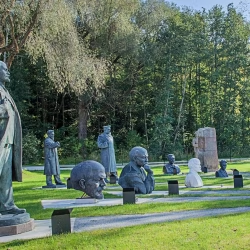The Topography of Terror (Topographie des Terrors) is a historical museum and outdoor exhibition located in Berlin, Germany. It stands on the site where the headquarters of the Gestapo, the SS leadership, and the Reich Security Main Office were once located during the Nazi regime. The museum and exhibition center delve deeply into the history of Nazi terror and its impact on Germany and the world.
Berlin, Germany, is a city brimming with history, but some chapters are darker than others. The Topography of Terror (Topographie des Terrors) is a powerful outdoor and indoor museum situated on a site that once housed the headquarters of the Nazi regime’s most notorious organizations: the Gestapo secret police, the SS paramilitary force, and the Reich Security Main Office (RSHA). Today, this chilling location serves as a stark reminder of the horrors of the Nazi era, offering visitors a chance to confront the past and learn from its devastating consequences.
The Topography of Terror – A Site Steeped in Terror

The museum’s main focus is to document and educate visitors about the atrocities committed by the Nazi regime between 1933 and 1945. It covers the mechanisms of repression, persecution, and genocide that were orchestrated from this very location. Through a combination of photographs, documents, and personal testimonies, the Topography of Terror provides a sobering and comprehensive look at this dark chapter in history.
The outdoor exhibition at the Topography of Terror features remnants of the Berlin Wall, which once divided the city during the Cold War era. This section of the exhibition explores the political and social ramifications of the Wall and its impact on Berliners and Germans as a whole.
The museum also hosts temporary exhibitions, lectures, and events that further explore various aspects of Nazi history, the Holocaust, and the aftermath of World War II. It serves as a place for reflection, remembrance, and learning, aiming to ensure that the atrocities of the past are never forgotten and to foster dialogue on issues of human rights, democracy, and justice.
The Topography of Terror is not just a museum; it is a significant memorial and educational institution that plays a crucial role in confronting Germany‘s past and promoting awareness and understanding among visitors from around the world. It stands as a poignant reminder of the consequences of totalitarianism and the importance of vigilance in safeguarding human rights and democratic values.
A Landscape of Remembrance

The Topography of Terror isn’t just a museum; it’s a landscape of remembrance. The outdoor exhibition features:
- Foundations of the Destroyed Buildings: The remaining foundations of the Nazi buildings are visible, serving as a powerful symbol of their downfall.
- Informative Panels: Scattered throughout the site are panels detailing the history of the Nazi regime, the organizations headquartered here, and the victims of their atrocities.
- The Exhibition Trench: An underground trench allows visitors to view archaeological excavations, uncovering remnants of the Nazi buildings and offering a tangible connection to the past.
The Topography of Terror – A Deeper Look Inside

The indoor museum provides a more in-depth exploration of the Nazi regime’s crimes. Exhibits explore:
- The Rise of the Nazi Party: Learn how the Nazis gained power and consolidated their control over Germany.
- The Machinery of Terror: Uncover the inner workings of the Gestapo, SS, and RSHA, and the methods they used to persecute and eliminate those deemed enemies of the state.
- The Persecution of Victims: The museum sheds light on the systematic targeting of Jews, political opponents, Roma (Sinti and Roma), homosexuals, and other groups deemed undesirable by the Nazi regime.
A Place for Reflection
The Topography of Terror isn’t a place for easy answers. It’s a place for reflection, education, and remembrance. The museum encourages visitors to confront the darkness of the past and learn from history’s mistakes to ensure such atrocities never happen again.
Planning Your Visit
The Topography of Terror is open year-round and offers free admission. Guided tours are available in English and other languages, providing a deeper understanding of the site’s history and significance.
Here are some additional tips for your visit:
- Allow enough time: The museum offers a lot to see and process, so plan to spend at least a few hours exploring the exhibits.
- Be prepared for emotional impact: The museum deals with sensitive topics, so be prepared for the emotional weight of the content.
- Learn from history: The Topography of Terror is a powerful reminder of the dangers of unchecked prejudice and authoritarianism. Let this experience inspire you to work towards a more just and tolerant world.
A Must-See for History Buffs
The Topography of Terror is a crucial stop for anyone seeking to understand the horrors of the Nazi regime and the importance of remembering the past. It’s a place of education, reflection, and a call to action to ensure such darkness never engulfs the world again.
Have you ever visited the Topography of Terror? Share your thoughts and takeaways from this important site in the comments below!








0 Comment